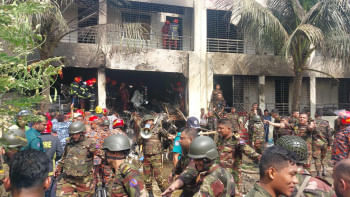A hospital without hygiene is the opposite of healthcare

To say that the healthcare system of Bangladesh has taken a battering over the last few years would be an understatement. We all remember the dark days at the height of the pandemic, when families of patients infected with Covid-19 desperately struggled to find space in hospitals. During that time, we found one thing to be the irrevocable truth – that basic hygiene in medical facilities is a matter of life and death, as any spreading of infection there could be very dangerous.
In a country that spends billions of dollars on large-scale development projects, how is it possible that healthcare facilities are not being able to meet minimum standards of basic hygiene and waste management? Are the authorities at all concerned that government facilities are doing much worse in meeting these standards?
Yet, it seems this lesson has either already been forgotten or it was never put into place. According to the latest Joint Monitoring Programme (JMP) report by WHO and UNICEF, 62 percent of healthcare facilities in the country still lack basic hygiene. The situation is especially bad in government facilities, where only 32 percent had basic hygiene services. The report warned that this state of affairs could be lethal for vulnerable patients, especially newborns and mothers.
The picture is equally bleak in terms of waste management. Only 34 percent of the facilities offer basic waste management services, and around 14 percent do not have them at all. This is especially worrying given that a huge amount of medical waste is generated every day. We have, on multiple occasions, reported on the repercussions of mismanagement of waste from healthcare facilities. It is not just bad for the environment; there is also a lucrative business surrounding its recycling where thousands of waste pickers, including children, wash blood, pus and chemicals and handle other toxic materials in the absence of proper waste management services.
In a country that spends billions of dollars on large-scale development projects, how is it possible that healthcare facilities are not being able to meet minimum standards of basic hygiene and waste management? Are the authorities, especially in the ministry of health, at all concerned that government facilities are doing much worse in meeting these standards? The situation is all the more concerning when one considers the fact that only six percent of non-government healthcare facilities actually have functioning medical licenses. While 59 percent have at least applied for license, 35 percent have not even bothered to register themselves in any way, and are operating without any oversight or transparency.
Only this week, the DGHS found a rise in the population of Aedes mosquitoes, sparking fears of an even bigger wave of dengue in the coming days. Earlier this year, the capital witnessed an outbreak of cholera. On top of that, the ever-increasing costs of living mean that people are even less likely to be able to spend on expensive medical care. In such a scenario, it is essential that the authorities do everything in their power to ensure that medical patients are not being let down in healthcare facilities because minimum standards are not being met.

 For all latest news, follow The Daily Star's Google News channel.
For all latest news, follow The Daily Star's Google News channel. 



Comments